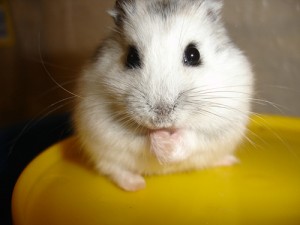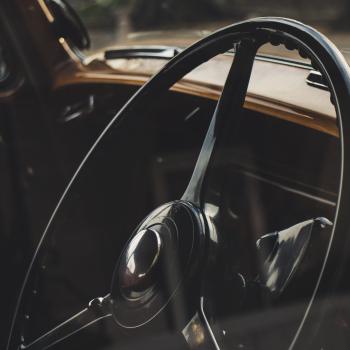In the final months before our hamster died, I would lie in bed late at night, wondering if he was still alive. In the quiet of the house, after my husband had left for work at 3:00 a.m. and my children were asleep in their beds, I would strain my ears to hear if there was any sound of movement from his cage.
Lying there in the dark, I would find myself holding my breath, straining to listen to whether—just one more time—I might hear the sound of him running on his wheel. But for the last several months that Fluff was alive, there was no sound from the cage at all, aside from the slow occasional rasp of his claws on the cage’s bedding as he painfully turned and the bubble of the water tank as he sucked a few pitiful drops down.
Hamsters, you remember, are nocturnal creatures. When Captain Von Flufficus arrived in our family in August 2013—the result of our nine-year-old’s persistent begging, I, for one, did not want to own a rodent—that was our family’s instantly rueful realization, as we all lay in our beds on our small second floor, unable to sleep, while he ran on the wheel all night long.
But it’s funny what you can get used to. After sooner than you think, I wondered what all the thousands of people who Google the phrase “quiet hamster wheel” were making a fuss about. Fluff’s nightly circumambulations, the wheel’s rapid susurrations, became a comfort, a marker of our existence. They were even more meaningful when we figured out that whenever one of us would make a nighttime bathroom trip, he would instantly freeze on the wheel and stare with his black bead eyes, ever alert and vigilant. (My husband does a fantastic and hilarious impression of him doing this.)
He’s doing God’s work, said my husband the sound engineer approvingly, the one who was also out on the road in the middle of the night, out with the produce deliverymen and the big ole McLane trucks restocking the 7-Elevens.
And of course there were all the pitfalls that happen when two urban children have a first-time pet: the time I walked into the kitchen to find that Anna Maria had stuffed the hamster into a plastic Cinderella carriage and I had to open the door and unfold him out of it, praying that he would still be breathing.
To say nothing of the quotidian failures of children who have been told, but relentlessly try to shirk, their duties in taking care of said pet: How many weeks did I yell at my son that it was time to clean out the damned cage, that we could smell it all over the upstairs?
Plus, there was just the general humor inherent in having another ridiculous animal in the house: Because he was a Syrian Teddy Bear hamster, we called him “the Antiochian hamster” as a nod to the Syrian home of our Orthodox church’s Patriarchate in Damascus.
One time he combed the paper bedding on the floor of his cage into a pile that reached almost to the top of it, as though he were building a Tower of Babel, and then promptly burrowed himself into the bottom to sleep all day. He had the kind of expression that seemed to say that he did not take any shit. And as he got older and his thick honey-colored hair started to recede, it became apparent, and endlessly amusing, that he had a pair of really giant testicles.
But the hair continued to recede, and what there was left of it turned white. “Sweetie, his hair is turning gray,” my husband said to me, sadly, and that sent us into a flurry of worry about skin disorders and whether this was an illness or a normal part of aging.
Here’s the point where I step in to wonder why we were expending so much energy on a pet—a rodent, for that matter—when there are people out in this world who are far more in need of care and attention.
But my thinking now, though, is that God gave us Fluff to show us how to care for the least among us. That the beginning of being truly a Person for Life was in caring for the smallest of creatures, and that caring for those animal creatures could be a point on a natural continuum of caring for tiny, quite possibly inconvenient and nonstandard humans.
In those final months, his fur receded so much that you could see the vertebrae sticking above his skin, and I would run my fingertip along that backbone as I held him in a cradle against my chest, the one time of the day before bed when we took him out of the cage to say hello to him.
He could no longer even crawl up into the wheel, and crept across the floor for his drops of water. “Mom, all he does anymore is sleep,” my son complained.
“We’re a hamster hospice now,” my husband said. It won’t be long.
Then, one summer day, we packed Fluff up in his cage, put him in the car, and left at last for our family vacation, snaking up I-95 through New York City and beyond, headed for the Massachusetts coast. We did not know it was the last day of his life as the car broke above the hill and the blue sweep of the Atlantic rose up above us. When we stopped for the night we fed him, watered him, and tucked him into bed.
In the morning, my son found him lying on his back, his claws finally stilled. Animals may not have souls, we are taught, but we still buried Fluff with prayers and a splash of holy water, and a grave marked with a flowering leaf. It was the right thing to do: He’d brought us closer to God.
A native of Yazoo City, Mississippi, Caroline Langston is a convert to the Eastern Orthodox Church. She is a widely published writer and essayist, a winner of the Pushcart Prize, and a commentator for NPR’s All Things Considered.

















